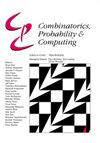关于对称随机矩阵的最小奇异值
IF 0.8
4区 数学
Q3 COMPUTER SCIENCE, THEORY & METHODS
引用次数: 5
摘要
我们表明,对于$n\times n$随机对称矩阵$A_n$,其对角线上和上面的条目是亚高斯随机变量$\xi$的独立副本,平均值为0,方差为1,\begin{equation*}\mathbb{P}[s_n(A_n) \le \epsilon/\sqrt{n}] \le O_{\xi}(\epsilon^{1/8} + \exp(\!-\Omega_{\xi}(n^{1/2}))) \quad \text{for all } \epsilon \ge 0.\end{equation*},这改进了Vershynin的结果,Vershynin得到了这样一个界,$n^{1/2}$被$n^{c}$代替了一个小常数c,并将$1/8$替换为$(1/8) - \eta$(隐式常数也取决于$\eta > 0$)。此外,当$\xi$是Rademacher随机变量时,我们证明\begin{equation*}\mathbb{P}[s_n(A_n) \le \epsilon/\sqrt{n}] \le O(\epsilon^{1/8} + \exp(\!-\Omega((\!\log{n})^{1/4}n^{1/2}))) \quad \text{for all } \epsilon \ge 0.\end{equation*}特殊情况$\epsilon = 0$改进了Campos, Mattos, Morris和Morrison最近的结果,该结果表明$\mathbb{P}[s_n(A_n) = 0] \le O(\exp(\!-\Omega(n^{1/2}))).$值得注意的是,与前两个关于对称矩阵奇点概率的最佳边界不同,这依赖于一些专门的和涉及组合技术,我们的方法完全符合Rudelson和Vershynin开创的广泛几何框架,并提出了一种研究对称随机矩阵奇异谱的原则性几何方法的可能性。我们工作中的主要创新是算法结构的新概念-中位数正则化最小公分母(MRLCD)和中位数阈值,它们是Vershynin引入的正则化最小公分母(RLCD)的自然改进,在需要组合向量不同部分的反集中信息的情况下应该更普遍有用。本文章由计算机程序翻译,如有差异,请以英文原文为准。
On the smallest singular value of symmetric random matrices
We show that for an
$n\times n$
random symmetric matrix
$A_n$
, whose entries on and above the diagonal are independent copies of a sub-Gaussian random variable
$\xi$
with mean 0 and variance 1,
\begin{equation*}\mathbb{P}[s_n(A_n) \le \epsilon/\sqrt{n}] \le O_{\xi}(\epsilon^{1/8} + \exp(\!-\Omega_{\xi}(n^{1/2}))) \quad \text{for all } \epsilon \ge 0.\end{equation*}
This improves a result of Vershynin, who obtained such a bound with
$n^{1/2}$
replaced by
$n^{c}$
for a small constant c, and
$1/8$
replaced by
$(1/8) - \eta$
(with implicit constants also depending on
$\eta > 0$
). Furthermore, when
$\xi$
is a Rademacher random variable, we prove that
\begin{equation*}\mathbb{P}[s_n(A_n) \le \epsilon/\sqrt{n}] \le O(\epsilon^{1/8} + \exp(\!-\Omega((\!\log{n})^{1/4}n^{1/2}))) \quad \text{for all } \epsilon \ge 0.\end{equation*}
The special case
$\epsilon = 0$
improves a recent result of Campos, Mattos, Morris, and Morrison, which showed that
$\mathbb{P}[s_n(A_n) = 0] \le O(\exp(\!-\Omega(n^{1/2}))).$
Notably, in a departure from the previous two best bounds on the probability of singularity of symmetric matrices, which had relied on somewhat specialized and involved combinatorial techniques, our methods fall squarely within the broad geometric framework pioneered by Rudelson and Vershynin, and suggest the possibility of a principled geometric approach to the study of the singular spectrum of symmetric random matrices. The main innovations in our work are new notions of arithmetic structure – the Median Regularized Least Common Denominator (MRLCD) and the Median Threshold, which are natural refinements of the Regularized Least Common Denominator (RLCD)introduced by Vershynin, and should be more generally useful in contexts where one needs to combine anticoncentration information of different parts of a vector.
求助全文
通过发布文献求助,成功后即可免费获取论文全文。
去求助
来源期刊

Combinatorics, Probability & Computing
数学-计算机:理论方法
CiteScore
2.40
自引率
11.10%
发文量
33
审稿时长
6-12 weeks
期刊介绍:
Published bimonthly, Combinatorics, Probability & Computing is devoted to the three areas of combinatorics, probability theory and theoretical computer science. Topics covered include classical and algebraic graph theory, extremal set theory, matroid theory, probabilistic methods and random combinatorial structures; combinatorial probability and limit theorems for random combinatorial structures; the theory of algorithms (including complexity theory), randomised algorithms, probabilistic analysis of algorithms, computational learning theory and optimisation.
 求助内容:
求助内容: 应助结果提醒方式:
应助结果提醒方式:


